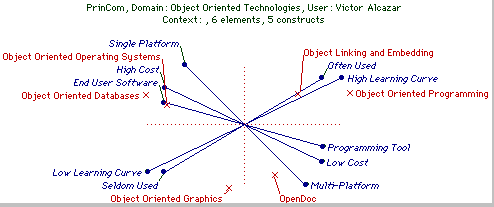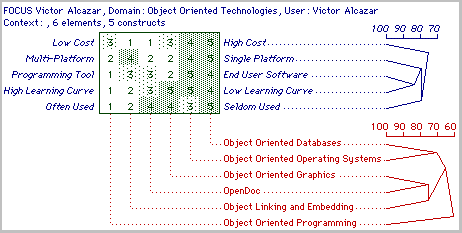Part I: Exploration
The domain of the new grid created was Restaurants. Different restaurants styles from fast food to gourmet were included. They are compared on a variety of categories including price, food type, dress, and food health content.The grid created gave a true account of how the different restaurants were alike or different. After entering all the constructs and elements, WebGrid was able to group Wendy's and McDonald's; and the RimRock and Owl's Nest. The FOCUS and PrinCom charts gave an accurate relationship of how these restaurants are related. However, it took some time to be able to visualize exactly how the graph was representing the data.
However, it was difficult to come up with several constructs. The person creating constructs should have indepth knowledge of what the different characteristics of elements in the domain are, and how these elements differ. In addition, there are some constructs which do not have degrees (a binary relationship) within them, but are still important in the comparison of elements. An example in the restaurant domain would be if the restaurant had wheelchair access.
Link to Grid
Part II: Exploration of Constructs on CPSC547 topics
The constructs were developed using the triad method. That method seemed to be the most effective in picking appropriate constructs. It was very difficult to come up with the latter constructs. This may be due in part to my relative inexperience with the Advanced Information Systems.The grid contained the elements initially defined by Dr. Gaines. The following constructs were then defined:
| Left | Right | |
|---|---|---|
| 1. | Text | Visual |
| 2. | Expensive Technology | Inexpensive Technology |
| 3. | Highly Implemented | Rarely Implemented |
| 4. | Easy to Use | Difficult to Use |
| 5. | Platform Independent | Platform Dependent |
Pictured below is the grid created in comparison to Dr. Gaines and the definitions of the comparison terms. The following section gives a summary of the construct comparisons.

Definition of Comparison Terms

Conventional Communication and Novel Communication (Dr. Gaines)
Correspondence. The terms do not relate whatsoever. However, they both carry similar distinctions.
Easy to Use and Difficult to Use (new)
Communication Technology and Application Technology (Dr. Gaines)
Correspondence. The terms do not relate whatsoever. However, they both
carry similar distinctions.
Text and Visual (new)
Targeted on Overall System and Targeted on Interface (Dr. Gaines)
Correspondence. The terms do not relate whatsoever. However, they both
carry similar distinctions.
Expensive Technology and Inexpensive Technology (new)
Application Technology and Communication Technology (Dr. Gaines)
Correspondence. The terms do not relate whatsoever. However, they both
carry similar distinctions.
Highly Implemented and Rarely Implemented (new)
Application Technology and Communication Technology (Dr. Gaines)
Correspondence. The terms do not relate whatsoever. However, they both
carry similar distinctions.
All the comparisons yielded correspondence. The terms did not match in any case, but they all had very similar distinctions. In some cases, the terms could have been attributes of the other (in the case of the last comparison), but there was no compensation for this in the terms defined for comparisons.
In all, the grids did not compare. This was most likely because Dr. Gaines and myself have different levels of experience with the Advanced Information Systems. Had our experience level and term vocabulary been more similar, there would have been a greater variation on the comparison terms.
Link to Grid
Part III: Elicitation of Constructs on Object Oriented Technologies
The constructs for Object Oriented Technologies appears in the table below. These were easier to create than the constructs for Part II. This was the case because knowledge about OOT was much more prevalent than with Advanced Information Systems. However, not covering each technology in depth, the constructs still did not materialize quickly.
| Left | Right | |
|---|---|---|
| 1. | Text | Visual |
| 2. | Expensive Technology | Inexpensive Technology |
| 3. | Highly Implemented | Rarely Implemented |
| 4. | Easy to Use | Difficult to Use |
| 5. | Platform Independent | Platform Dependent |
The PrinCom graph uncovered a few surprises. The constructs Often
Used and High Learning Curve appeared in the same area.
This would indicate that although, there are some complex technologies,
there are still being used. I disagree with the positioning of two
constructs, however. Low Cost and Multi-Platform are
relatively close to each other, however in actuality they should be
quite distant.


Link to Grid
Part IV: Conclusion
Although much of the results of WebGrid were factual, the end results did not justify the preliminary work. The same results could have easily been interpreted from a spreadsheet and its corresponding graph.The triad method was effective in the learning process of WebGrid, however once the initial question were overcome, triad became more of a nuisance than a help. Personally, I preferred adding a construct and then rating each element afterward.
Perhaps, the criticisms are too harsh. During the exploration, I may not have encountered the true objectives of WebGrid. I also wondered whether I was working with too few elements and constructs. Would I have the same opinions if this were not the case? Perhaps, the qualities of WebGrid did not become apparent in this attempt, but will become evident in a future session.